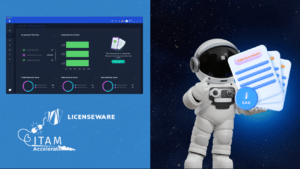Navigating Oracle EBS Licensing in 2025: Key Insights for IT Leaders

Introduction
Oracle E-Business Suite (EBS) continues to be a mission-critical system for thousands of organizations worldwide in 2025. However, the licensing landscape for this powerful enterprise solution has grown increasingly complex, presenting both challenges and strategic opportunities for IT leaders, procurement specialists, and financial officers.
Understanding Oracle’s licensing models isn’t merely a technical exercise; it’s a strategic business decision with significant financial implications. The right licensing approach can save your organization millions of dollars, while the wrong choice can lead to unexpected costs, compliance issues, and operational constraints.
In our comprehensive Oracle E-Business Suite (EBS) Licensing Guide for 2025, we explore every aspect of Oracle EBS licensing in detail. This blog post provides a condensed overview of the key insights from that guide, highlighting the essential information you need to make informed licensing decisions.
Let’s explore the four primary licensing models available for Oracle EBS in 2025, key compliance considerations, and strategies to optimize your Oracle investment while minimizing risks.
The Four Oracle EBS Licensing Models at a Glance
Oracle offers four primary licensing models for E-Business Suite in 2025, each with distinct advantages and considerations:
Application User Licensing (User-Based Model)
This traditional model licenses individual named users who access the EBS applications. Key characteristics include:
- Licensing Basis: Per individual user with system access
- Cost Structure: Direct correlation between user count and licensing costs
- Advantages: Precise control, predictable scaling with user growth, straightforward compliance tracking
- Challenges: Administrative overhead for user management, potentially costly for broad deployments
- Best For: Organizations with limited, well-defined user populations and targeted EBS deployments
Under this model, each person with access rights requires a dedicated license regardless of usage frequency. Organizations must implement rigorous user management practices to maintain compliance while avoiding unnecessary licensing costs.
Revenue Metric Licensing (Enterprise Revenue-Based)
This enterprise-wide model bases licensing costs on your organization’s total annual revenue:
- Licensing Basis: Total company revenue (typically per $1M in revenue)
- Cost Structure: Scales with business growth rather than system usage
- Advantages: Unlimited user access, simplified administration, no user tracking required
- Challenges: Costs increase automatically with revenue growth, potential disconnect between system usage and licensing costs
- Best For: Large enterprises with high user-to-revenue ratios and predictable revenue growth patterns
Revenue Metric licensing eliminates user counting in favor of a simpler enterprise-wide approach, but creates a direct link between business success and licensing costs.
Employee Metric Licensing (Enterprise Employee-Based)
Similar to Revenue Metric but based on workforce size rather than financial performance:
- Licensing Basis: Total employee count across the organization
- Cost Structure: Scales with workforce growth rather than system usage
- Advantages: Unlimited user access, simplified administration, natural fit for HR-focused implementations
- Challenges: Requires clear definition of “employee” for counting purposes, costs increase with workforce expansion
- Best For: Organizations with stable employee counts and high system adoption rates across the workforce
This model works particularly well for HR-focused implementations and organizations where employee count provides a more stable metric than revenue.
Custom Application Suite (CAS) Licensing
This flexible approach allows organizations to create tailored bundles of EBS modules:
- Licensing Basis: Customized combination of modules with negotiated terms
- Cost Structure: Bundle pricing typically offering discounts compared to individual module licensing
- Advantages: Cost efficiency through bundling, administrative simplification with unified terms
- Challenges: Complex initial negotiation, reduced flexibility for partial termination
- Best For: Organizations implementing multiple EBS modules with clear long-term requirements
CAS licensing provides the ability to create precisely tailored module bundles with unified terms while potentially realizing significant discounts compared to individual module licensing.
For a detailed analysis of each model, including compliance considerations, real world examples, and migration strategies between models, refer to our comprehensive Oracle E-Business Suite (EBS) White Paper.
Choosing the Right Licensing Model for Your Organization
Selecting the optimal Oracle EBS licensing model requires careful consideration of your organization’s specific characteristics and requirements:
Key Decision Factors
- User Distribution: How many users need access and how are they distributed across modules?
- Growth Projections: What are your anticipated growth patterns for revenue, employees, and system users?
- Module Requirements: Which EBS modules are essential for your business operations?
- Administrative Capabilities: What resources do you have for managing user licenses and compliance?
- Budget Structure: Do you prefer predictable per-user costs or enterprise-wide metrics?
Organizations should conduct a Total Cost of Ownership (TCO) analysis across multiple licensing scenarios, modeling different growth projections to identify the most advantageous approach for both current needs and future evolution.
Essential Compliance and Cost Optimization Strategies
Regardless of which licensing model you choose, these strategies are critical for maintaining compliance while controlling costs:
Proactive Compliance Management
- Regular Internal Audits: Conduct comprehensive self-assessments at least annually, with focused reviews quarterly.
- Robust Documentation: Maintain meticulous records of licensing entitlements, deployment configurations, and user access rights.
- User Access Governance: Implement strict provisioning and de-provisioning processes with regular access reviews.
- Technical Controls: Monitor database options, virtualization configurations, and customizations that may impact licensing.
- Formal Governance: Establish clear roles, responsibilities, and processes for license management.
Cost Optimization Best Practices
- Eliminate Shelfware: Regularly review module usage and deactivate unused functionality.
- Optimize User Access: Implement role-based access control aligned with licensing boundaries.
- Strategic Timing: Plan licensing changes to coincide with Oracle’s fiscal year-end (May 31) for potential negotiation advantages.
- Leverage Bundling: Consider Custom Application Suite licensing for multi-module implementations.
- Regular Model Assessment: Periodically evaluate whether your current licensing model remains optimal as your organization evolves.
Oracle Audit Readiness
Oracle license audits have become increasingly common and sophisticated in 2025. Key preparation strategies include:
- Understand Audit Triggers: Be aware that mergers, acquisitions, support renewals, and cloud migration discussions often trigger audits.
- Prepare Documentation: Maintain comprehensive records of license entitlements, deployment configurations, and compliance activities.
- Validate Findings Thoroughly: Never accept audit findings at face value; thoroughly verify all data, assumptions, and conclusions.
- Negotiate Strategically: Approach remediation discussions with clear understanding of your options and leverage points.
- Learn and Improve: Use audit experiences to drive lasting improvements in license management practices.
For detailed guidance on compliance procedures, optimization techniques, and audit management, consult our comprehensive Oracle E-Business Suite (EBS) White Paper.
Conclusion: Mastering Oracle EBS Licensing in 2025
Oracle E-Business Suite licensing represents a significant investment and potential risk area for organizations. As we’ve explored in this blog post, understanding the four primary licensing models—Application User, Revenue Metric, Employee Metric, and Custom Application Suite—is essential for making informed decisions that align with your business needs and growth trajectory.
Beyond model selection, effective Oracle EBS licensing management requires:
- Strategic planning that considers both current requirements and future evolution
- Proactive compliance monitoring with regular internal audits
- Disciplined user and access management for user-based licensing models
- Technical configuration controls to prevent inadvertent licensing exposure
- Formal governance structures with executive awareness and support
Organizations that master these elements can achieve the optimal balance between cost efficiency, operational flexibility, and compliance security.
For a comprehensive deep dive into Oracle EBS licensing, including detailed model descriptions, compliance considerations, cost optimization techniques, and audit management strategies, we encourage you to read our estensive Oracle E-Business Suite (EBS) White Paper. This extensive resource provides the detailed knowledge and practical guidance needed to navigate the complex Oracle licensing landscape with confidence.
Remember that Oracle licensing is not merely a technical or procurement concern—it’s a strategic business consideration with significant financial implications. By investing time in understanding your options and implementing robust management practices, your organization can maximize the value of its Oracle investment while minimizing financial and operational risks.
Have you reviewed your Oracle EBS licensing recently? What challenges has your organization faced with Oracle licensing compliance or optimization? Get in touch if you need help: contact@licenseware.io










